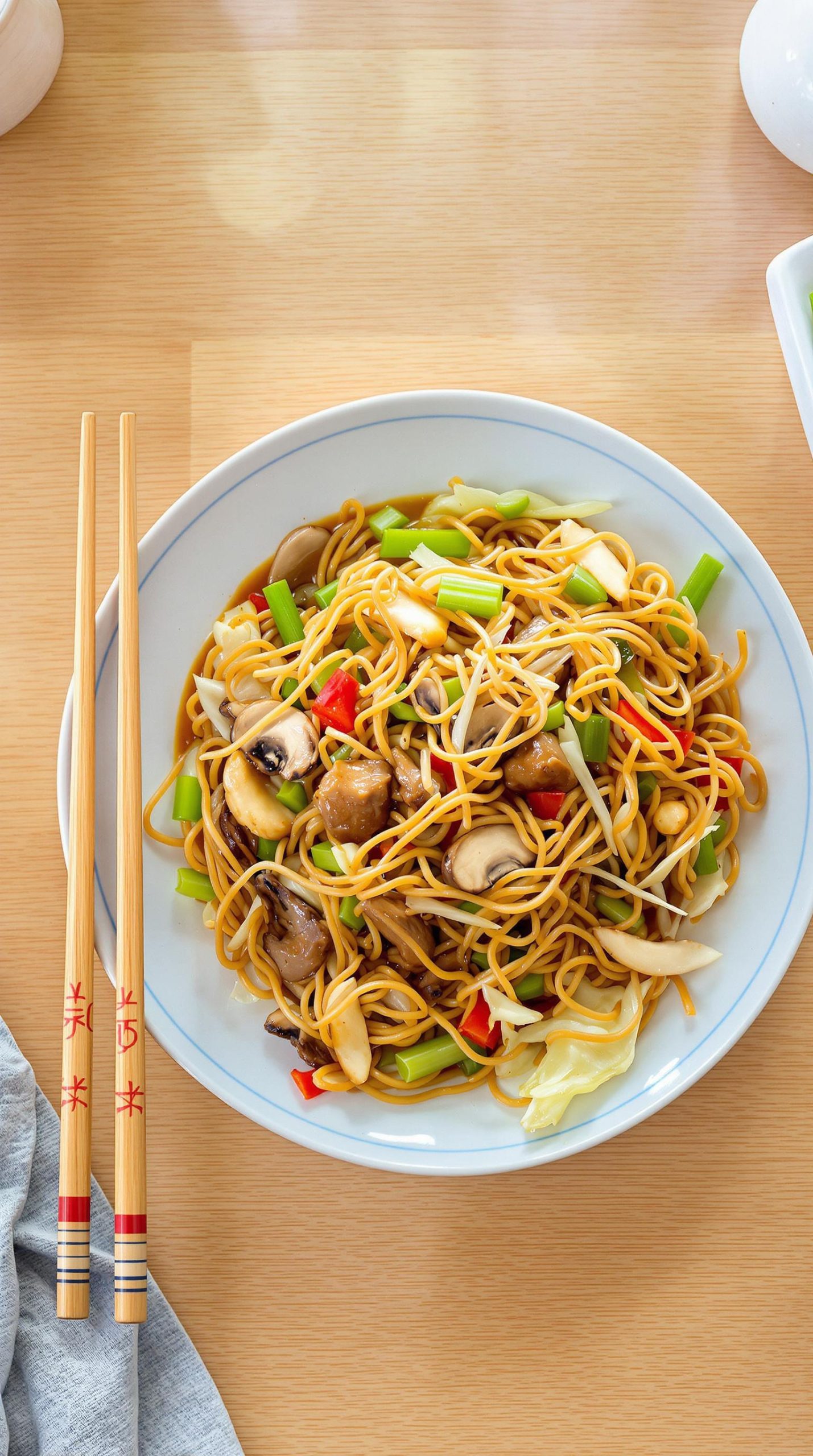Why You’ll Love this Homemade Pork Chow Mein
If you’re searching for the perfect weeknight meal that combines convenience with authentic flavor, I’m convinced this homemade pork chow mein will become your new favorite.
Unlike takeout, you control exactly what goes into your dish—tender pork, crisp vegetables, and just the right amount of seasoning.
Ready in under 30 minutes, it’s faster than delivery. The beautiful mix of textures—from the slightly crunchy noodles to the tender pork—creates a satisfying bite every time.
Plus, the versatility is amazing. No mushrooms? Skip them. Prefer chicken? Easy swap. Got leftover veggies? Toss them in.
Your family will request this regularly, trust me.
What Ingredients are in Homemade Pork Chow Mein?
Creating authentic pork chow mein at home requires a handful of fresh ingredients that combine to deliver that perfect balance of flavors and textures. The beauty of homemade Chinese dishes like this is that you can really taste each component—the savory pork, the crisp vegetables, and those distinctive chow mein noodles that tie everything together.
I’m always amazed at how such simple ingredients transform into something so satisfying and reminiscent of my favorite takeout, but honestly even better.
- 1 pound pork stew meat
- 1½ teaspoons seasoning salt
- 1 medium onion, chopped
- 1-2 garlic cloves
- 1 cup chopped celery
- ¾ cup chopped red, yellow, and orange peppers
- 5 mixed mushrooms
- ½ cup bamboo shoots
- 3 cups thinly sliced white cabbage
- ½ (14 ounce) bag chow mein noodles
- 3 tablespoons soya sauce
- Salt and pepper to taste
- Oil or margarine for frying
When shopping for these ingredients, quality matters. Look for fresh, tender cuts of pork—if you can’t find stew meat, a pork tenderloin works wonderfully when cut into bite-sized pieces.
For vegetables, crispness is key, so select firm cabbage and peppers with vibrant colors. The bamboo shoots and mushrooms can typically be found in the Asian food section of your grocery store if fresh aren’t available.
And while traditional chow mein calls for specific noodles, don’t stress if you can only find lo mein or even thin spaghetti in a pinch—it’s the technique and sauce that really bring the dish to life.
How to Make this Homemade Pork Chow Mein

Making homemade pork chow mein is surprisingly straightforward, and the results are absolutely worth the effort. Start by heating a bit of oil or margarine in a large frying pan over medium-high heat. Add 1 pound of pork stew meat and sprinkle with 1½ teaspoons of seasoning salt, browning the meat on all sides. This initial searing locks in those savory juices that will later infuse the entire dish. The pork should develop a nice golden color—don’t rush this step, as it’s where so much of the flavor foundation begins. For easier meal prep, consider using a premium food processor to quickly chop all your vegetables uniformly.
Once your pork is nicely browned, toss in 1 medium chopped onion and 1-2 garlic cloves, sautéing for about 2 minutes until they become fragrant and slightly translucent.
Now it’s time for the vegetable medley: add 1 cup of chopped celery, ¾ cup of colorful chopped peppers, a5 mixed mushrooms, ½ cup of bamboo shoots, and 3 cups of thinly sliced white cabbage. Stir everything together and continue cooking until the vegetables soften but still maintain a bit of crispness.
Meanwhile, bring a pot of water to boil for your noodles. Cook the ½ bag (about 7 ounces) of chow mein noodles for approximately 4 minutes—slightly less than package directions suggest. This helps prevent them from becoming soggy when combined with the other ingredients.
After draining and rinsing the noodles with hot water, add them directly to your frying pan with all those beautiful vegetables and pork. Investing in quality kitchen tools can make this cooking process more enjoyable and efficient. Drizzle 3 tablespoons of soya sauce over everything and give it a good toss to make sure every noodle is coated and every bite contains that perfect blend of ingredients.
Season with salt and pepper to taste, though you may find the seasoning salt and soya sauce provide enough flavor on their own. The final dish should have a wonderful balance of textures—tender pork, slightly crisp vegetables, and perfectly cooked noodles—all enveloped in that distinctive umami flavor that makes chow mein so irresistibly craveable.
Homemade Pork Chow Mein Substitutions and Variations
The beauty of homemade pork chow mein lies in its flexibility—you can easily customize this classic dish to suit your preferences or pantry inventory.
Don’t have pork? Chicken works wonderfully, or try beef for a heartier version.
Vegetarians can skip the meat entirely and double up on mushrooms for that umami flavor.
Not a fan of cabbage? Bok choy makes a delicious substitute.
Those bamboo shoots can be replaced with water chestnuts for extra crunch.
And if you’re watching carbs, try using spiralized zucchini instead of traditional noodles.
The saucing can be adjusted too—a dash of oyster sauce adds richness.
What to Serve with Homemade Pork Chow Mein
Side dishes can transform your homemade pork chow mein from a simple meal into a complete Chinese feast. I love pairing it with steamed vegetable dumplings or crispy egg rolls for that authentic restaurant experience.
A small bowl of hot and sour soup makes a perfect starter, while some garlic bok choy provides a fresh, green element to balance the noodles.
Don’t forget about drinks! Jasmine tea is traditional, but a cold Tsingtao beer works wonderfully with these flavors.
For dessert? Keep it light with orange slices or fortune cookies. Who doesn’t smile when cracking open those little prophecies?
Final Thoughts
After mastering this homemade pork chow mein recipe, you’ll never need to order takeout again. I’m confident you’ll be amazed at how simple it’s to recreate this Chinese classic in your own kitchen. The combination of tender pork, crisp vegetables, and those signature noodles creates a dish that’s both satisfying and versatile. For a different homemade snack option, try making Chex Mix recipe that requires just an hour of baking with occasional stirring for perfect results. Much like the popular Cracker Barrel meatloaf recipe, this dish brings restaurant-quality comfort food right to your dining table.





